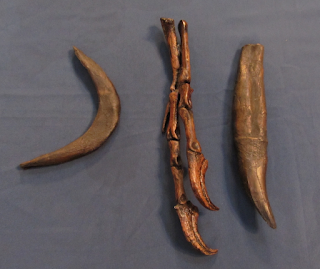After an introduction by Dr. Steve Le Comber, Dr. Dave read two short extracts from the book. The first, on a method of prey despatch, was especially illuminating and memorable for me simply because the conjecture never once occurred to me, but which once posited made such elegant sense:
‘The huge caudofemoralis muscles ran from the femur and up most of the first third of the tail in all dinosaurs. The tail gave a huge amount of power to the legs for running, was full of major blood vessels and was not surrounded by bone. A heavy bite anywhere around the thigh or first part of the tail might well have crippled an animal, leaving it unable to run and bleeding badly. Also, the tail was one of the first things a pursuing hunter would encounter in a fleeing animal, so using this technique would have reduced the chase distance, which would have been important especially if the prey animal was fundamentally faster than the tyrannosaur. Notably, there are two fossil hadrosaurs showing injury to the tails from tyrannosaur bites, and another with a wound to the leg; it’s a very limited data set, but it does nonetheless point to this as a strategy.’
After the readings, the audience was treated to a live link-up via Skype with the book’s illustrator, Scott Hartman, whose trusted, accurate skeletals I’m sure require no introduction here. Dr. Dave prefaced this by pointing out the precision of Scott’s working methods, and recounting how, during the course of writing the book, when Dave was asked whether he had a second choice in mind in the event that Scott couldn’t be procured, his answer was a quite decisive ‘well, no.’
The last of the formalities was the purchasing and signing of copies of the book (all which were brought to the launch sold out), whilst guests also had time to ogle at, photograph, and even handle the various casts that were on display.
 |
| Dave points out that the manus here belongs to Albertosaurus rather than T. rex |
It was a great pity that Marc couldn’t make it this time, or without question there would have been some choice goofy pictures with the fantastic skull, and you would have had a superior post than this besides (in more ways than one). Never mind. I did at any rate get a picture of another star who also happened to be there.
 |
| Luis Rey! |














